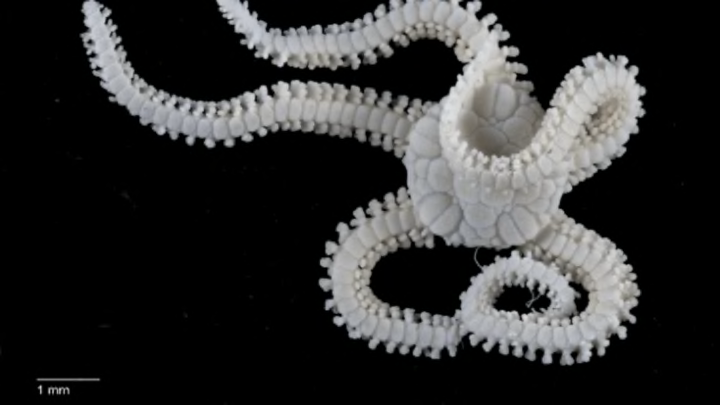Biodiversity Patterns Are Even Stranger in the Deep Sea

Space missions are exciting, but we still have a whole lot of exploring to do here on Earth. Oceans cover more than 70 percent of our planet, and more than half of the ocean is deep, deep water. Yet we know very little about our oceans, let alone the deep sea. Today, for example, a letter published in the journal Nature reports that biodiversity follows different patterns in the darkest depths of the ocean.
Life in the deep sea (between 1.24 and 4.04 miles down) is pretty strange to begin with. The deep is the realm of mate-absorbing anglerfish, of giant crabs and frilled sharks and vampire squid. This is a land of darkness and of creatures that live on sea snot. So it’s not a huge surprise that even scientific concepts like biodiversity tend to bend the rules down here.
Brittlestar (Macrophiothrix spongicola) from southern Australia. Image credit: J. Finn
The letter’s authors came to that conclusion after surveying the distribution of 2099 species of Ophiuroidea, an order that includes brittle stars and basket stars like the ones shown here. The researchers chose Ophiuroidea for three main reasons: there are a lot of them; they live in all three strata (shallow, mid-depth, and deep water); and they tend to dominate any ecosystem they inhabit.
Tropical brittle star (Ophiothrix purpurea) wrapped around a coral. Image credit: J. Finn
Banded brittle star (Astrogymnotes hamishia) found off New Caledonia. Image credit: C. Harding
The authors compiled data on Ophiuroidea distribution from 1614 research expeditions around the world. Analysis of the 165,044 records showed that some very unusual stuff was happening in the deepest parts of the ocean. For one thing, biodiversity in the deep sea increased with latitude, so the greatest deep-sea biodiversity took place farthest from the equator. The opposite is true for shallow and mid-depth regions.
In the shallower waters of the continental shelf, temperature was a driving factor for biodiversity. The warmer the water, the more species you’d find. However, the researchers found no such pattern in the deep. Instead, it was the availability of food that drove species diversity.
The patterns of biodiversity represented in the deep are so distinct from those in shallow water that the researchers proposed designating it as a third biome; that is, instead of land and ocean, there’d be land, shallow ocean, and deep ocean.
This is fascinating science, but it’s also important data for marine conservation, in which biodiversity is used to measure ecosystem health.
“These results have important implications for identifying potential protected areas on the high seas,” the authors write, “both within and outside national jurisdictions.”